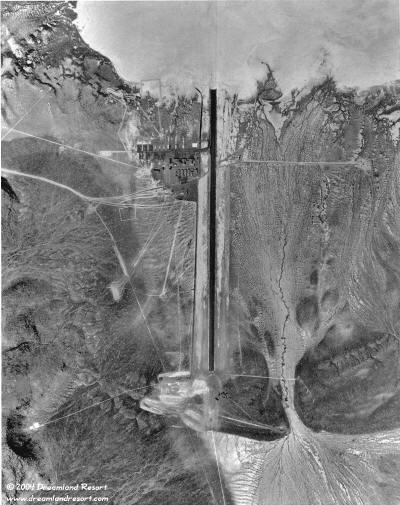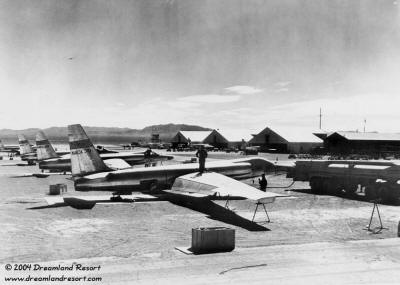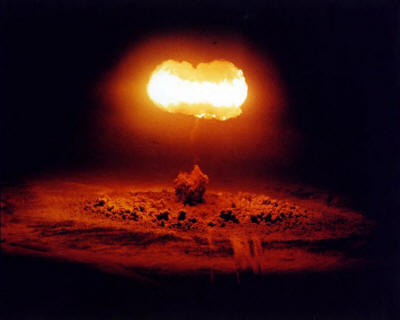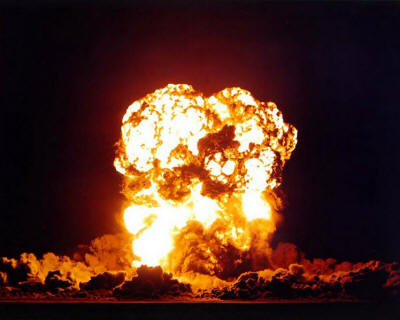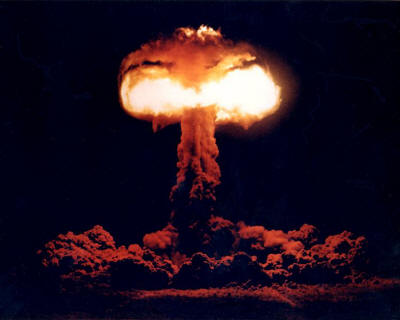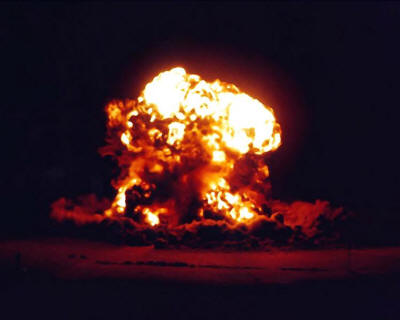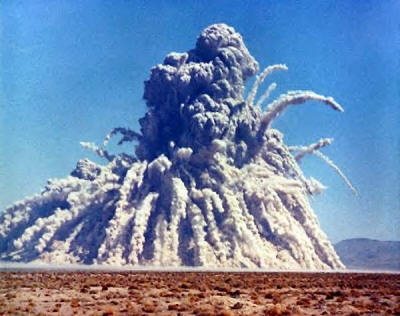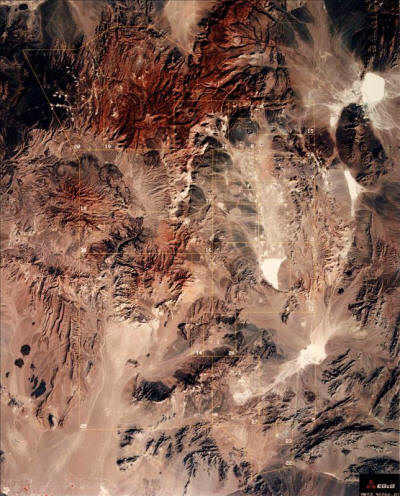|
(extracted from "Area
51 - Dreamland - Fifty Years of Secret Flight Testing in Nevada" by Peter W.
Merlin)
This aerial view shows the Watertown Airstrip at Groom Lake in 1959. The paved runway is 5,000 feet long.
Skunk Works chief Clarence "Kelly" Johnson selected a site, but it was rejected by Richard M. Bissell, Jr., of the CIA and his Air Force Liaison, Col. Osmond J. Ritland because it was too close to populated areas. Ritland recommended Groom Dry Lake, Nevada, on the Las Vegas Bombing and Gunnery Range. At first, Johnson objected to Groom Lake because of its proximity to the Atomic Energy Commission (AEC) nuclear proving ground at Yucca Flat.
Not only were atomic bombs being detonated above ground just 12 miles to the southwest, Groom Lake was also directly downwind of the radioactive fallout clouds. Johnson relented when he realized that the military and AEC restrictions on the surrounding area would help provide security for the U-2 operation.
Nevertheless, atmospheric testing of
nuclear weapons plagued the secret base with radioactive fallout and
other hazards for many years.
According to Fuller, the AEC monitored radioactive contamination at the Groom Mine through the use of sticky pans, air and water samples, dosimeters [radiation detectors], and even live rabbits. The Sheahans were informed that there would be "a lot of radioactive dust,...and the clouds would be coming in the direction of the Groom Mine."
As Fuller describes the fallout from
interviews with surviving Sheahan family members, it "would just
sweep in, thick as a dry thunder shower, just as heavy and just as
pelting as actual rain." Cattle, horses, and deer in the Groom area
were later observed dead or injured with beta burns, a form of
radiation damage from fallout.
In later years, this necessity would
plague the workers at the secret Groom Lake airfield with the need
to suspend operations and evacuate personnel during nuclear tests.
The airfield at Watertown, on the southwest corner of Groom Lake, as it appeared during the 1950s. U-2 aircraft were parked north of the hangars and west of the runway.
The existence of the facility at Groom Lake was announced by the AEC in 1955, during its construction. The airbase was called Watertown, a name that was commonly used for the facility until 1958 when it was added to the Nevada Test Site as Area 51. In fact, Watertown is still officially listed as a member of Alamo Township in Lincoln County.
It was described as,
It noted that the base included
"dormitories, equipment, buildings, and a small airstrip."
The booklet did include a cover story that the National Advisory Committee for Aeronautics (NACA) had,
In fact, U-2 aircraft at Waterown were
painted in NACA markings to protect the cover story in the event
that one of them was lost off-site.
Shot STOKES was fired from a balloon above Area 7. It exploded with a yield of 19 kilotons. The fallout cloud passed through the Groom Lake area.
Since they were detonated when the wind was blowing generally northeast, the shots usually deposited fallout on the Groom Lake area. In 1955 and 1956, there were 14 more. The 1957 test series, Operation Plumbbob, included 24 nuclear detonations and six safety experiments (three of which had a slight nuclear yield). These tests frequently required the evacuation of personnel from Watertown, interrupting flight test and crew training operations.
According to the memo, the,
It was also cautioned that,
It was requested that this position be passed on to the Nevada Test Organization planning board, and that the Board should determine,
At this time, the Groom Lake facility was only being used for the U-2, and was expected to be deactivated as the aircraft and crews were dispersed to overseas bases for operational missions.
The memo states:
The evacuations must have been
inconvenient to Watertown personnel, as they would have had a severe
impact on flight test and training schedules.
Shot SMOKY was fired atop a steel tower in Area 2, adjacent to some hills. It had a yield of 44 kilotons. SMOKY's dusty cloud deposited radioactive fallout over the Groom Lake area.
The first shot of Operation Plumbbob was a safety experiment called Project 57. Such tests were usually conducted to determine that a weapon or warhead damaged in an accident will not detonate with a nuclear yield, even if some or all of the high-explosive components burn or detonate. Because the non-nuclear explosion would disperse nuclear materials, such as plutonium, the Project 57 test was mainly used for developing decontamination and radiation monitoring techniques.
It was later determined that there was
minor alpha activity for 12 days following the shot, but it was well
below operational guidelines.
Blast effects at Watertown
It was a 10-kiloton device, lofted on a balloon to height of 500-feet above Area 9 in the northern part of Yucca Flat. The mushroom cloud climbed to 30,779-feet where a steady wind blew it northeast. Meanwhile, WILSON's stem was blown in the opposite direction towards California.
Balloon shots were somewhat cleaner than tower shots because there was no steel structure to vaporize and contribute to the fallout cloud. Shot HOOD was fired on 5 July 1957. It was lofted by balloon to a height of 1,500-feet over Area 9, about 14 miles southwest of Watertown. The device exploded with a yield of 74 kilotons, the most powerful airburst ever detonated within the continental United States. HOOD's nuclear cloud drifted over Groom Pass and the Papoose Range, depositing fallout on the Groom Lake area and its shock wave damaged a number of buildings at Watertown.
By
mid-June 1957, the U-2 test operation had moved to Edwards AFB,
California, and the operational U-2 aircraft were assigned to the
4028th Strategic Reconnaissance Squadron at Laughlin, Texas. This
was just as well. The airbase was about to be rocked as never
before.
A maintenance building on the west side
of the base had its west and east doors buckled, and the south door
of the supply warehouse west of the hangars buckled in.
Shot DIABLO was fired on top of a 500-foot steel tower in Area 2 on 15 July 1957. It had a yield of 17 kilotons (the bomb dropped on Hiroshima, Japan, during World War II had a 13KT yield). Radiation safety (RAD-SAFE) monitors instrumented buildings and vehicles at Watertown to measure radiation-shielding capabilities of materials commonly found in an average U.S. town.
The airbase included structures made from wood, sheet metal, plaster and other materials commonly found in an average American small town. Therefore, the data provided information on the characteristics of these materials to protect inhabitants against radioactive fallout. The information was logged in tables of "shielding data" for later study. Watertown shielding data from several shots, including DIABLO, is now available to any interested person at the DOE Public Reading Facility in Las Vegas, Nevada.
The data tables for DIABLO list readings taken at the Groom Mine main residence, a wood-frame house where radiation levels reached a maximum of 80 milliroentgens per hour (mR/hr). By comparison, normal background levels are between 0.02mR/hr and 0.04mR/hr. Readings were taken at Watertown in several rooms inside wood-frame dormitory Building 103. Levels varied from 12mR/hr to 30mR/hr inside the building. Readings inside Trailer 10, with four-inch-thick aluminum and wood walls, went off-scale three hours after DIABLO detonated.
Within an hour, levels dropped to 65mR/hr, and then 24mR/hr 90 minutes later.
Another truck, two miles west of
Watertown only received 0.3mR/hr inside the cab and 0.5mR/hr
outside.
The decision to test the A-12 and train CIA pilots at Groom Lake meant that the base would not only have to be expanded, but almost entirely rebuilt. The expansion of the base included new hangars, dormitories, runways, and fuel storage facilities. By 1960, Watertown was commonly known as Area 51, a designation that would appear on most documents and maps for the next two decades.
The Air Force took control of the site
in 1977, and it has only continued to grow.
Shot SEDAN was part of the Plowshare program for peaceful uses of nuclear explosives. The device was buried at a depth of 635 feet to maximize its cratering potential. SEDAN exploded with a yield of 104 kilotons, blasting a crater 320 feet deep and 1,280 feet across in the sandy soil of Area 10 on Yucca Flat. Fallout from the shot drifted over Groom Lake.
There were, however, several cratering tests conducted in support of Project Plowshare. This endeavor called for the use of nuclear explosives for excavation of canals, harbors, and mountain passes. To prove the feasibility of such peaceful uses of nuclear explosives, devices were buried at a depth that would allow the maximum amount of soil to be displaced.
The largest cratering shot was SEDAN, on
6 July 1962. The 104-kiloton thermonuclear device left a crater
1,280 feet across and 320 feet deep. Again radioactivity was
detected off-site. Shot ANACOSTIA was a low-yield device development
test on 27 November 1962. No radioactivity was detected beyond the
boundaries of the Test Site.
These draft reports provide insight into
the manner in which nuclear testing impacted operations at Area 51.
The analyses for both shots cover the following areas: predicted
effects, atmospheric overpressures, radiation, base surge and ejecta,
possible damage to Groom Lake road, evacuation from Area 51, and
possible delays in firing.
The reports state that,
To reduce risk of radiation exposure, personnel were to be evacuated as with so many previous shots.
Additionally, the duration of the
evacuation would "depend on reliability of contamination predictions
and in-field measurements. Re-occupancy is expected by D+4 although
field conditions may require short work shifts for several days,
possibly two to three weeks."
Both shots were cancelled.
This satellite view of the Nevada Test Site shows all the major test areas. The craters on Yucca Flat are clearly visible. Groom Lake (Area 51) is just off the northeast corner of the NTS near Area 15.
When shot TIJERAS was fired on 14 October 1970, Donald Bruskert recorded his observations outdoors at Area 51.
According to Bruskert, the motion came "in rolling waves" five seconds after detonation, and that there was "no jolt." According to the DOE list of United States Nuclear Tests, the yield of the blast was between 20 and 200 kilotons. The ground motion lasted for 25 seconds. During shot ARTESIA, on 16 December 1970, William Moore felt the shock distinctly inside the Area 51 security building. Donald Bruskert, standing outdoors, described the motion from the "20 to 200" kiloton blast as "questionable."
Air Force, CIA, and civilian contractor
personnel at the secret airbase willingly accepted these risks in
order to accomplish their mission: to develop advanced aircraft and
systems in defense of the United States.
|

